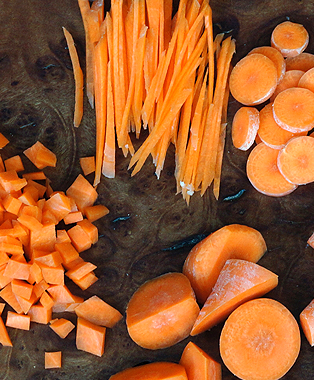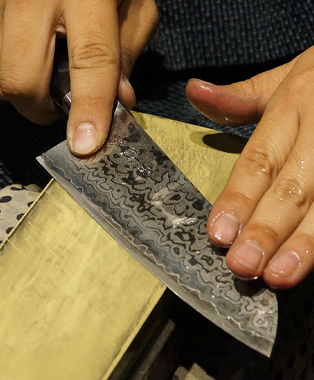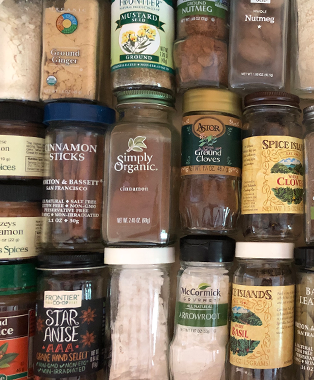01
Cleaning vegetables
If it’s an organic vegetable it’s fine not to peel it. Simply scrub it with a vegetable brush to remove any dirt and enjoy the skin. The skins of most vegetables contain nutritional benefits that are best not discarded.
___
Vegetables and leafy greens tend to last longer in the refrigerator if they are washed right before use. Leafy greens can be washed in a salad spinner or bowl of cold water. You may need to rinse them a few times if necessary. When the rinse water looks clean, the vegetable should be ready to cook.

02
Vary cutting styles for vegetables
How well you vary your cutting styles can bring added nutritional value to the vegetable plate. Slices or rounds, matchsticks, chunks, sticks, and grating present a variety of surfaces on the vegetable in cooking and therefore express different nutrients; it’s best to vary your methods of cutting.
03
Vary cooking methods for vegetables
The same is true of cooking methods: boiling, steaming, sautéing in water or broth, blanching, or (almost) waterless cooking in a ceramic pot, are all good ways to cook vegetables. You might prefer to eat a raw vegetable now and then. If so, grated, julienned or sticks might be best.
04
Vary seasoning
We all get in ruts, so it’s important to try different seasonings. Besides more elaborate sauces simple seasonings for vegetables can be gomashio (a ground mixture of sesame seeds and sea salt)*, vinegars, lemon juice, mustard, horseradish, sauerkraut, garlic, onion, scallions, tahini, toasted seeds, ground almonds, shoyu or soy sauce, or grated ginger. Fresh herbs like dill, thyme, rosemary, oregano, parsley, caraway seeds and marjoram are excellent for variety and taste. Cumin, coriander, and turmeric are preferred spices to cook with, as they have added nutritional and health benefits.
___
*You can buy gomashio or make it by rinsing brown sesame seeds in water, then toasting in a pan over low heat until lightly browned or until they break when pinched between your fingers. Next, lightly toast sea salt in the same pan. I use a ratio of 18:1, sesame seeds to sea salt, until the salt smells slightly metallic. Be careful not to brown the salt. Grind seeds and salt in a suribachi (mortar and pestle) by stirring in the same direction until 90% of the seeds are ground. Used sparingly, it imparts a satisfying salty taste.
05
The best way to cook rice
Rinse the rice several times by swirling it in a bowl of water and straining it through a sieve. When the water runs almost clear place the rice in a bowl with 2 cups of water per cup of what I call evening grains ( short grain brown rice, Golden Rose, etc. ). For morning porridge use 4 cups of filtered water per cup of sweet or brown rice. Soak the grains for 8 hours or overnight. Place the rice and soaking water in a pressure cooker and bring to a gentle boil, then add a pinch of sea salt. Cover and bring to full steam, reduce the heat and slide a flame deflector under the pot. Cook for 50 minutes. The pressure gauge will indicate when it’s time to open the lid. You may use this method to cook other whole grains, or a mixture of brown rice and grains like millet, barley, whole oats, etc.
___
Rice may also be cooked in a rice cooker, or pot with a tight fitting lid. (See more versions on cooking rice in recipe section.)

06
A sharp knife is a timesaver
One of my cooking teachers used a clever marketing strategy to advertise her class: she promised to tell us the most important cooking tip we would ever need to know. The big secret was to keep the knives sharp!
___
A demonstration on knife sharpening followed but, before I could yawn, this simple realization turned out to be one of the most important cooking tips I ever learned. Not one to sharpen my knives often, I never realized the stress on my shoulders, hands and arms as I tried to saw through a simple carrot with a dull blade, let alone carve into a squash with a thick skin, or a hard root vegetable. There is a terrific advantage to being able to slice a burdock root into tiny matchsticks for a sauté, or thinly slice onions, cucumbers, cabbage, etc. for a pressed salad.
___
More surface area equals more nutrients, period. I fooled myself into believing I would be a purist and sharpen my knives on a stone with water, but I quickly gave in and purchased an electric sharpener. They shorten the life of the knife a bit, but save time, and keep the cut edges very precise. If you’re lucky (which I am) and can find a professional knife-sharpener, this is the best way to go.
—
My favorite knife is an 11″ Japanese vegetable knife with “dimples” on the edge to help the slicing and dicing process.
07
Cooking beans
Too many people avoid beans because they think they are “gassy.” Beans are an excellent source of protein in a plant-based diet, or any diet. To improve their digestibility, wash the beans and then soak them in water with a 1” piece of kombu. Discard the soaking water, but keep the kombu. Place kombu in a saucepan with the beans. Cover with fresh water and bring to a gentle boil. Cook uncovered for ten minutes, skimming off any foam. Cover and continue to cook on low heat, adding a pinch or two of sea salt at the end of cooking.

08
Arrange your kitchen for optimal convenience
A friend did this for me one night. At first I was a little miffed, but quickly realized that the kitchen can get in a rut too. My spices were too far away from the place where I prepared the food. My counter was congested with non-essentials, and some pots and pans were inconveniently placed in a cabinet that required a stepladder to reach.
___
A big deterrent to cooking is time, so I rearranged my kitchen for optimum convenience: The glasses are above the dishwasher—easy in, easy out; same with the dishes, on which the finished product will be served. I stripped my counters of everything except a line-up of mason jars filled with beans, seeds, and grains; they don’t take up much space and provide inspiration. The spice drawer is organized alphabetically. My cookbook cabinet overfloweth, so I stored the ones I wasn’t using elsewhere and filled it with my favorites. I keep the knife sharpener out—plugged in and ready for action—but the lemon juicer, blender, mixer, etc. are all out of sight, yet ready to spring into action. Heaven in the kitchen is enough horizontal surfaces on which to work, easy grabability of essentials, and the absence of clutter.
09
Adjust cooking methods to the seasons
Summer is the time to relax, lighten up, and help the body reverse from the winter climate. You can do this with food and food preparation. Salads cool us, so does steaming or quick-boiling food. We require less salt in the summertime, and benefit from eating lighter foods like leafy greens, the upward growing spring and summer vegetables, and cooler temperature foods. Condiments like vinegar, lemon, parsley, and fresh herbs are all excellent and cooling foods.
___
Conversely, in winter we want to eat warming foods, like the downward growing root vegetables that can be stored, and hardier greens like kale. A little more sea salt, miso or sauerkraut is beneficial, and seasonings such as scallions, ginger and dried herbs. Cooking methods move from lighter steaming to slow simmer, sautés, and pressure cooking.
10
Be mindful of food combinations
In this age of digestive sensitivity it’s important to recognize the implications of certain combinations of food. Grains, beans, pasta, or fish can all be combined with vegetables with minimal intestinal discomfort. Fruit should be stewed or cooked in some way and melon needs to be eaten as a stand-alone fruit.
___
To avoid excess gas in your digestive tract, avoid eating fruit with any sweets, beans, vegetables, grains, or animal protein. If you pay attention to your gut you will understand which food combinations are problematic and which are not. (I fine-tuned my own investigation on melons down to one simple fact—honeydews agree with me, cantaloupes do not. ) There are so many gastrointestinal problems in our society, this is one simple way to alleviate at least some of them.

